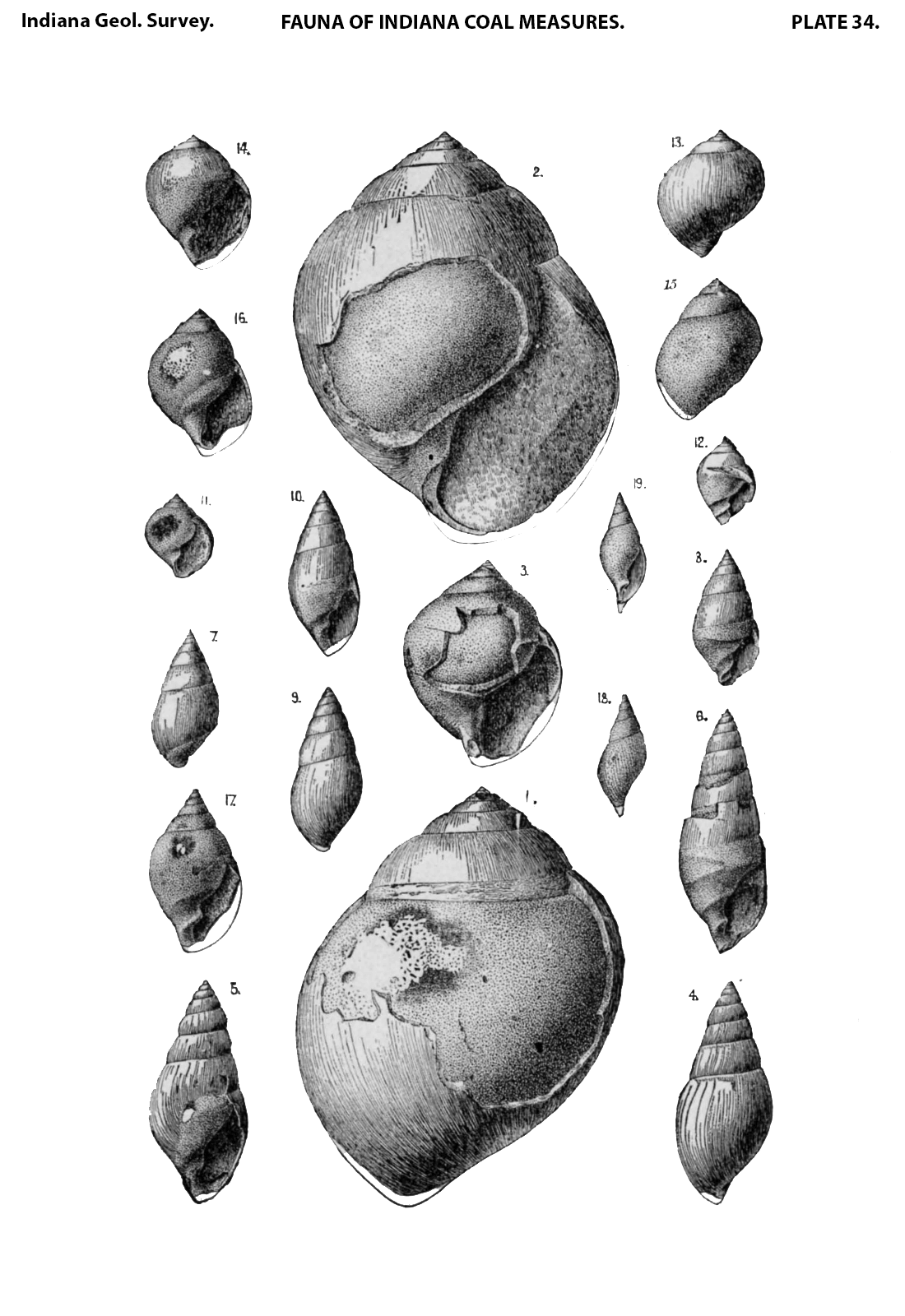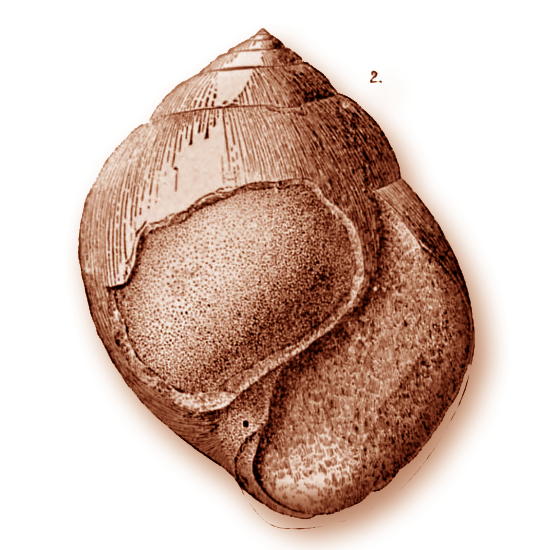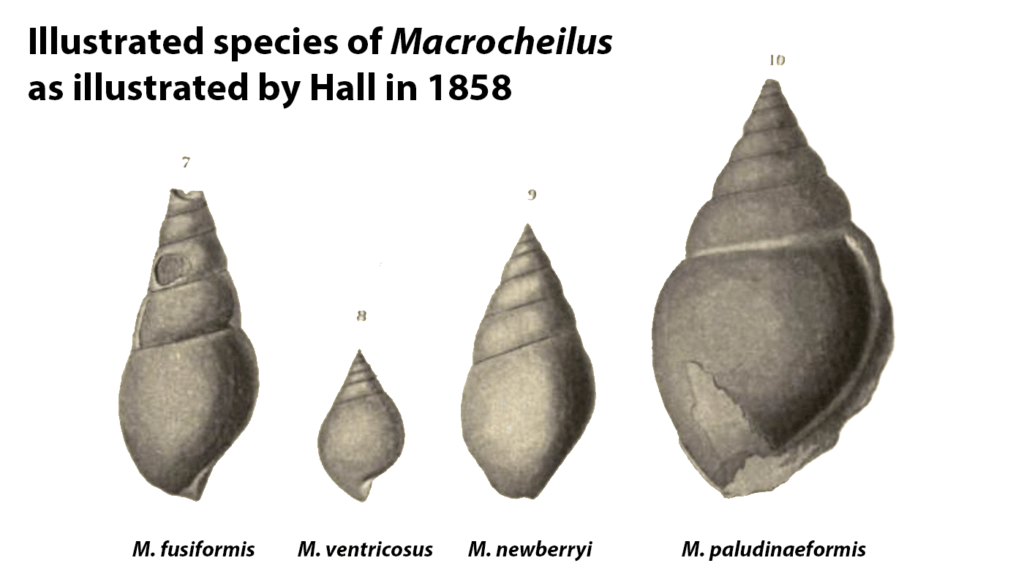In doing broader research on three species of Strobeus that occur within the Glenshaw Formation in Western Pennsylvania, I have discovered many excellent plates by former authors. These plates are miniature works of art, capturing details of these fossil gastropods that may not be available in photographs. The art can be a mixed bag, as authors would fill in or invent details that didn’t exist. You’ll often see the overdrawn outlines that show what the specimen would look like if it remained in perfect shape.
Many of these specimens do not have correlating identification numbers, so finding the originals can be next to impossible. However, some rare examples exist, such as when an author illustrates a holotype. This text will review two of these historical plates. The first plate we will examine is one by Charles A. White, published in 1884 as part of a report on the fossil fauna of the “Coal Measures” (Pennsylvanian) in Indiana. The second will be a plate by George H. Girty in 1915 as part of his report on the fossil fauna of the Wewoka Formation of Oklahoma.
White’s Plate 34 from the Year 1884
Plate 34 in White’s report on the Fossils of the Indiana Rocks, No. 3, is an excellent representation of fossil gastropods known today under the genus Strobeus. White assigned all specimens on the plate to the genus Solenisus Meek and Worthen 1860, with the majority given to the subgenus Macrocheilus Phillips 1841.
White wrote that the assignment within the subgenus Macrocheilus was confusing. Unfortunately, an unknown printing error reversed this plate’s genus and subgenus names for Soleniscus (Macrocheilus). This mistake initially made correlation tricky, as I only used the plate. Fortunately, someone caught the error before it appeared on Plate 8 of Proceedings of the United States National Museum, Volume 6, 1883, a loaned version of Plate 34.
Still, White’s base genus for all these was Soleniscus, a situation that Knight proclaimed was the root of many problems across the family, the Subulitidae. In his own words: “For example, differences of opinion as to the true characters of Soleniscus typicus Meek and Worthen formed the basis of several misunderstandings.” Figures 18 and 19 on the following plate represent the type species of Solenisus, Soleniscus typicus.

Later Authors’ Interpretations of White’s Identifications
Between Girty (1915) and Knight (1931), the pair reassigned most of White’s figures to other species, and all but one belonged to a new genus in modern times. White was particular when discussing his doubts about the taxonomic assignment for his figures. For example, he mentioned that Soleniscus (Macrocheilus) fusiformis, S. (M.) newberryi, and S. (M.) planus would be difficult to compare, even with complete collections of all three. Knight (1931) placed all of White’s figures of these three species under Soleniscus (Macrochilina) regularis. White also had doubts about his identification of figures 13 and 14, S. (M.) texanus, and figures 15 and 16, S. (M.) medialis. Girty correlated figures 13 and 14 to S. primogenius, and Knight placed figures 15 and 16 under the same.
Girty (1915) considered Soleniscus ponderosa from this plate a synonym of Sphaerodoma primigenius [sic] by suggesting that they are the same species. He also felt the same about S. texanus; others saw it as a younger (i.e., juvenile) S. ponderosa. Finally, Knight discusses S. ponderosa, calling it one of the largest examples of S. primigenius [sic] yet recovered.
Knight (1931) split White’s Macrocheilus (Soleniscus) ventricosus into two species, with figure 11 going to S. primogenius and figure 12 assigned to S. brevis. White (1881) had created the species S. brevis earlier but did not mention it in the 1884 publication. With the size of these publications and the technology to publish at the time, it’s possible his new species was unknown when making the plates. The last figures, 18 and 19, are copies of the holotype of Soleniscus typicus, thus retaining their name, which is still valid today.
Girty (1915) assigned these species under the genus Sphaerodoma Keyes. Knight (1931) went full circle and reassigned species under Soleniscus (Macrocheilus). It would be interesting to know if Girty and Knight had discussed the matter. They both did extensive reviews that included these species, but 16 years apart. Knight reviewed the Subulitidae, whereas Girty examined the entire fossil fauna of the Wewoka Formation of Oklahoma (353 pages worth). He dedicated 23 whole pages to Sphaerodoma.
| Stated Species by White in 1884 | Figure | Known Today As |
|---|---|---|
| Soleniscus? (Macrocheilus) ponderosus | 1-2 | Strobeus primogenius |
| Soleniscus? (Macrocheilus) primigenius | 3 | Strobeus primogenius |
| Soleniscus (Macrocheilus) fusiformis | 4-6 | Strobeus regularis |
| Soleniscus (Macrocheilus) newberryi | 7-8 | Strobeus regularis |
| Solenisus planus | 9-10 | Strobeus regularis |
| Soleniscus (Macrocheilus) ventricosus | 11 | Strobeus primogenius |
| Soleniscus (Macrocheilus) ventricosus | 12 | Strobeus brevis |
| Soleniscus (Macrocheilus) texanus | 13-14 | Strobeus primogenius |
| Soleniscus? (Macrocheilus) medialis | 15-16 | Strobeus primogenius |
| Soleniscus (Macrocheilus) paludinaeformis | 17 | Strobeus paludinaeformis |
| Solenisus typicus | 18-19 | Solenisus typicus |
Girty’s Plate No. 24 from the Year 1915
In 1915, Girty published a monograph of the fossils of the Wewoka Formation of Oklahoma. In the publication, he provided 35 well-detailed fossil plates. The publication was very long, weighing in at 353 pages. Having been published over 100 years ago, it is no surprise that all the species represented on plate XXIV (24) now have new generic assignments. Knight (1931) reassigned most to the genus Soleniscus (Macrocheilus) again, restoring the genus and subgenus White (1884) had used. Over the intervening years, most of these species changed generic names, identifiable as Soleniscus, Polyphemopsis, Sphaerodoma, Strobeus, Ianthinopsis, and back to Strobeus again after a paper by J. Harper in 1981.

In figure 13, Girty includes a copy of Conrad’s illustration of Plectosylus primogenius on his plate for use in comparison. Knight agreed with Girty’s figures 14-17, placed Girty’s figures 9 through 12 of S. brevis under S. primigenius, and put figure 8 as Auriptygma simplex. Knight also correlated figure 4 S. ventricosa and 7 S. brevis var as S. paludinaeformis. He placed S. ventricosa under S. paludinaeformis after examining the type specimens authored by James Hall. He concluded that the only apparent difference was their size.
Knight placed figure 8 under Auriptygma simplex. Later in 1936, he changed all North American specimens identified under Auriptygma to a new genus, Leptoptygma. He was enlightened after taking a European trip to view many genotype specimens. Knight was better informed on the relationship between North American examples and their European counterparts since he could study them in person.
Hall (1858) created three new species under the genus Macrocheilus. M. fusiformis, M. ventricosus, and M. paludinaeformis. I’ve included a few figures from Hall’s plate in a graphic below. You can get a rough idea of why Knight (1931) combined M. ventricosus and M. paludinaeformis. Knight concluded that M. paludinaeformis was an adult specimen, whereas M. ventricosus was a juvenile of the same.
Girty considered both S. ponderosa and S. texanus as junior synonyms of S. primogenius and felt that S. texanus was a younger S. ponderosa (=S. primogenius). His identified figures of S. primogenius are still a valid species today. The specimen’s age came into consideration for figures 4 and 7. Knight (1931) placed both of these under S. paludinaeformis, considering them juveniles.
Sphaerodoma intercalaris from figures 1 and 2 is known today as Strobeus intercalaris. Sphaerodoma gracilis, figure 3, is known as Soleniscus gracilis.
| Stated Species by Girty in 1915 | Figure | Known Today As |
|---|---|---|
| Sphaerodoma intercalaris | 1-2 | Strobeus intercalaris |
| Sphaerodoma gracilis | 3 | Soleniscus gracilis |
| Sphaerodoma ventricosa | 4 | Strobeus paludinaeformis |
| Sphaerodoma paludiniformis | 5-6 | Strobeus regularis |
| Sphaerodoma brevis var. | 7 | Strobeus paludinaeformis |
| Sphaerodoma brevis | 8 | Leptoptygma simplex |
| Sphaerodoma brevis | 9-12 | Strobeus primogenius |
| Sphaerodoma primigenia | 13-17 | Strobeus primogenius |
References
- Conrad, T. A., 1835, Description of five new species of fossil shells in the collection presented by Mr. Edward Miller to the Geological Society: Geological Society of Pennsylvania Transactions, v. 1, pp. 267–270
- Cox, E. T., 1857, Palaeontology report of Coal Measure Mollusca. Kentucky Geological Survey, vol. 3, p. 566, pl. 8, fig. 2. 3:557–576
- de Koninck L.G., 1881. Faune du calcaire carbonifère de la Belgique, 3e partie, Gastéropodes. Musée Royale d’Historie Naturelle Belgique Annales, Série Paléontoloque, v. 6, 170 p.
- Girty, G. H., 1915, Fauna of the Wewoka Formation of Oklahoma, U.S. Geological Survey, Bulletin 544, 353 p.
- Hall, J, 1858, Palaeontology of Iowa. Report of the Geological Survey of the state of Iowa, v. 1, pt. 2, pp. 473-724
- Harper, J. A., 1981, The use: and misuse: of Ianthinopsis Meek and Worthen, 1866 (Mollusca: Gastropoda), Journal of Paleontology, v. 55, no. 1, pp. 180-185
- Hoare, R.D., 1961, Desmoinesian Brachiopoda and Mollusca from southwest Missouri. University of Missouri Studies v. 36, 262 p.
- Hoare, R.D., Sturgeon, M.T., and Anderson Jr., J.R., 1997, Pennsylvanian marine gastropods from the Appalachian Basin. Journal of Paleontology, v. 71, no. 6, pp. 1019-1039
- Knight, J. B., 1931, The Gastropods of the St. Louis, Missouri, Pennsylvanian Outlier: The Subulitidae. Journal of Paleontology, v. 5, no. 3, pp. 177–229.
- Knight, J. B., 1936, Notes on Paleozoic Gastropoda, Journal of Paleontology, v. 10, no. 6, pp. 520-534
- Norwood, J.G., and Pratten, H., 1855, Notice of fossils from the Carboniferous Series of the western states belonging to the genera Spirifer, Bellerophon, Pleurotomaria, Macrocheilus, Natica, and Loxonema, with descriptions of eight new characteristic species. Journal of the Academy of Natural Sciences of Philadelphia 3: pp. 71-77
- Perner, J., 1903, Système silurien du centre de la Bohême, v. 4, Gastéropodes, tome 1, 164 pp.
- White, C.A., 1884, Fossils of the Indiana rocks, No. 3: Indiana Department of Geology and Natural History, 13th Annual Report, pp. 107-180


